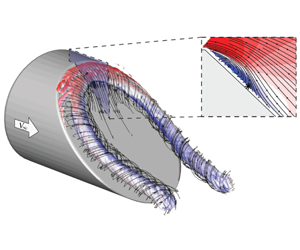Crossref Citations
This article has been cited by the following publications. This list is generated based on data provided by
Crossref.
Ranjan, Rajesh
and
Gaitonde, Datta
2020.
Hysteresis in slanted-base-cylinder afterbody flows.
Aerospace Science and Technology,
Vol. 106,
Issue. ,
p.
106138.
Zigunov, Fernando
Sellappan, Prabu
and
Alvi, Farrukh
2021.
Beyond actuator line arrays in active flow control studies: Lessons from a genetic algorithm approach.
Physical Review Fluids,
Vol. 6,
Issue. 8,
Zigunov, Fernando
Sellappan, Prabu
and
Alvi, Farrukh S.
2021.
An empirical platform for optimal placement of open-loop microjet-in-crossflow actuators.
Yu, Zhou
and
Bingfu, Zhang
2021.
Recent Advances in Wake Dynamics and Active Drag Reduction of Simple Automotive Bodies.
Applied Mechanics Reviews,
Vol. 73,
Issue. 6,
Ranjan, Rajesh
Garmann, Daniel J.
and
Gaitonde, Datta
2021.
Compressibility Effects on Flow Behind a Simulated Transport Aircraft Fuselage.
He, Kan
Minelli, Guglielmo
Su, Xinchao
Gao, Guangjun
and
Krajnović, Siniša
2022.
On state instability of the bi-stable flow past a notchback bluff body.
Journal of Fluid Mechanics,
Vol. 931,
Issue. ,
Liu, Qiong
Gaitonde, Datta V.
and
Ranjan, Rajesh
2022.
Global Stability Analysis of Flow Behind an Upswept Aftbody.
AIAA Journal,
Vol. 60,
Issue. 2,
p.
1257.
Chen, Xiaodong
Zhong, Shan
Ozer, Ozgun
and
Weightman, Andrew
2022.
Control of afterbody vortices from a slanted-base cylinder using sweeping jets.
Physics of Fluids,
Vol. 34,
Issue. 7,
Zigunov, Fernando
Sellappan, Prabu
and
Alvi, Farrukh S.
2022.
Compressibility effects on the wake of a cylinder with a slanted afterbody.
Siddiqui, Naseeb Ahmed
and
Agelin-Chaab, Martin
2022.
Flow features of the Ahmed body at a low Reynolds number.
International Journal of Heat and Fluid Flow,
Vol. 98,
Issue. ,
p.
109052.
Siddiqui, Naseeb Ahmed
and
Agelin-Chaab, Martin
2022.
Experimental investigation of the flow features around an elliptical Ahmed body.
Physics of Fluids,
Vol. 34,
Issue. 10,
Zigunov, Fernando
Sellappan, Prabu
and
Alvi, Farrukh
2022.
Hysteretic flow regime switching in the wake of a cylinder with a slanted afterbody.
Experiments in Fluids,
Vol. 63,
Issue. 5,
Zigunov, Fernando
Sellappan, Prabu
Alvi, Farrukh
Ozawa, Yuta
Saito, Yuji
Nonomura, Taku
and
Asai, Keisuke
2022.
Time-resolved particle image velocimetry and pressure sensitive paint measurements of afterbody flow dynamics.
Physical Review Fluids,
Vol. 7,
Issue. 2,
Tashiro, Kodai
Yokota, Sho
Zigunov, Fernando
Ozawa, Yuta
Asai, Keisuke
and
Nonomura, Taku
2022.
Slanted cylinder afterbody aerodynamics measured by 0.3-m magnetic suspension and balance system with six-degrees-of-freedom control.
Experiments in Fluids,
Vol. 63,
Issue. 8,
Ranjan, Rajesh
Robinet, J.-Ch.
and
Gaitonde, Datta
2022.
Instability mechanisms in meandering streamwise vortex pairs of upswept afterbody wakes.
European Journal of Mechanics - B/Fluids,
Vol. 96,
Issue. ,
p.
90.
Zigunov, Fernando
Sellappan, Prabu
and
Alvi, Farrukh
2022.
A bluff body flow control experiment with distributed actuation and genetic algorithm-based optimization.
Experiments in Fluids,
Vol. 63,
Issue. 1,
Tashiro, Kodai
Yokota, Sho
Zigunov, Fernando
Ozawa, Yuta
Nonomura, Taku
and
Asai, Keisuke
2022.
Aerodynamic Hysteresis and Reynolds Number Effect of Slanted Cylinder Afterbody in Magnetic Suspension and Balance System.
Guo, Pengming
Kaiser, Frieder
and
Rival, David E.
2023.
Vortex-wake formation and evolution on a prolate spheroid at subcritical Reynolds numbers.
Experiments in Fluids,
Vol. 64,
Issue. 10,
Tashiro, Kodai
Yokota, Sho
Ozawa, Yuta
Asai, Keisuke
and
Nonomura, Taku
2023.
Strut Interference with Flow around Slanted Cylinder Levitated by Magnetic Suspension and Balance System.
Rao, Hanyue
Chen, Yifu
Shi, Yayun
Yang, Tihao
and
Liu, Hongyang
2023.
Adjoint-Based Aerodynamic Design Optimization and Drag Reduction Analysis of a Military Transport Aircraft Afterbody.
Aerospace,
Vol. 10,
Issue. 4,
p.
331.

 $20^{\circ }$,
$20^{\circ }$,  $32^{\circ }$ and
$32^{\circ }$ and  $45^{\circ }$ with spatially dense measurements. Principal flow features of the mean flow field are identified, showing the connection between the main counter-rotating vortex pair observed in the wake and the separation bubble observed at the leading edge of the slant. A full reconstruction of the three-dimensional mean flow field using stacked stereoscopic particle image velocimetry reveals intricate details of this flow and clearly shows the direct connection between the two features. To our knowledge, this is the first direct measurement of the full three-dimensional flow topology for this geometry. The separation bubble length is found to be directly proportional to the slant angle and inversely proportional to the Reynolds number. Furthermore, the circulation within the primary vortex pair increases with increasing slant angle. This strengthening of the vortices is correlated to the form drag of this body in the vortex-dominated regime. A bi-stable steady-state wake is also observed in this flow at a low Reynolds number for the slant angle of
$45^{\circ }$ with spatially dense measurements. Principal flow features of the mean flow field are identified, showing the connection between the main counter-rotating vortex pair observed in the wake and the separation bubble observed at the leading edge of the slant. A full reconstruction of the three-dimensional mean flow field using stacked stereoscopic particle image velocimetry reveals intricate details of this flow and clearly shows the direct connection between the two features. To our knowledge, this is the first direct measurement of the full three-dimensional flow topology for this geometry. The separation bubble length is found to be directly proportional to the slant angle and inversely proportional to the Reynolds number. Furthermore, the circulation within the primary vortex pair increases with increasing slant angle. This strengthening of the vortices is correlated to the form drag of this body in the vortex-dominated regime. A bi-stable steady-state wake is also observed in this flow at a low Reynolds number for the slant angle of  $45^{\circ }$, where the formation of either a separated wake flow state or a vortex-dominated flow state is dependent upon initial conditions, i.e. the presence of overshoot of the free-stream velocity during wind tunnel start-up.
$45^{\circ }$, where the formation of either a separated wake flow state or a vortex-dominated flow state is dependent upon initial conditions, i.e. the presence of overshoot of the free-stream velocity during wind tunnel start-up.